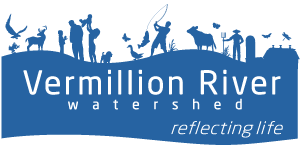Frequently Asked Questions
Of all the government agencies, watershed organizations tend to slip under the radar. You might not see them very much outside of your property taxes. But healthy watersheds are vital to a healthy environment – and the Vermillion River Watershed is no exception. Here are some frequently asked questions we hear from some folks:
A. A watershed is the area of land that drains to a river, lake, or other waterbody. If a raindrop falls anywhere inside the watershed, it will eventually find its way to the main waterbody. We all live in a watershed.
A. The Vermillion River Watershed is the largest watershed in the Minneapolis-St. Paul seven-county metropolitan area. The watershed drains 335 square miles in Dakota, Goodhue, and Scott counties.
The river’s headwaters emerge in New Market Township, Scott County. The Vermillion River main stem travels 35 miles west to east, joined by four major tributaries (North Creek, Middle Creek, South Creek, and South Branch) and many unnamed minor tributaries. The watershed includes 49 miles of Minnesota Department of Natural Resources-designated trout streams. The river meets the Mississippi River near Red Wing.
The watershed encompasses farmland, suburban developments, industrial zones, parks, open spaces, cities, and townships, including Apple Valley, Burnsville, Castle Rock Township, Coates, Douglas Township, Elko New Market, Empire, Eureka Township, Farmington, Hampton, Hampton Township, Hastings, Lakeville, Marshan Township, New Market Township, Nininger Township, Ravenna Township, Rosemount, Vermillion, and Vermillion Township.
A. Maybe! Type in your address at this link and see if it falls within our boundaries: https://dakotacounty.maps.arcgis.com/apps/webappviewer/index.html?id=304d2225249d4fd3ab3f510e0ff62a7f
A. Watershed organizations are local government units responsible for protecting, managing, and improving the water resources of their areas. In Minnesota, we have watershed districts (WDs) and watershed management organizations (WMOs). WMOs specifically exist in the Twin Cities Metro Area and are often joint-powers organizations between cities or counties. Dakota and Scott counties signed a joint powers agreement in 2002 to form the VRWJPO (as a WMO) and manage the watershed as required by Minnesota Statutes 103B and Minnesota Rules 8410.
The VRWJPO’s work is set by its Watershed Management Plan, which must be updated every ten years. The Plan is developed through an inclusive public engagement process, reviewing water monitoring results, and research on changes in local demographics and land use. The JPO also puts in place some rules and policies in cooperation with local governments. Read more on that here.
Day-to-day, VRWJPO staff spend their time planning water resource improvement projects, meeting with partners, or doing community outreach on water stewardship.
A. It can get confusing, we know. Here are some breakdowns of responsibilities, based on different water resource aspects. You’ll see how the VRWJPO fits into each of them.


